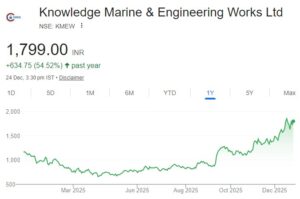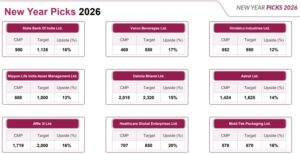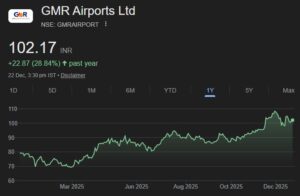Warren Buffett once said that instead of struggling day & night to find a multi-bagger and landing up with worthless stocks, if an investor was to quietly buy shares of blue chip companies and hold onto them for a sufficiently long period of time, the process of compounding that these stocks offer would itself ensure that the investor’s stock portfolio multiplies several times over.
Warren Buffett gave the example of Coca Cola to prove his point. Warren Buffett pointed out that Coca Cola made a public issue of shares in 1919 at about $19 per share. One year later, the share price had plunged 50%. After that there were numerous other problems faced by Coca Cola such as sugar shortage, water shortage etc. There was also a World War fought from 1939 to 1945 when the demand for Coca Cola must have been almost neglible. There was inflation, currency fluctuation and numerous other problems faced by Coca Cola apart from cut-throat competition from arch rival Pepsi. But if an investor held on to that one share and reinvested the dividends in buying shares of Coca Cola, his investment would be worth several million dollars, emphasizes Warren Buffett.
Warren Buffett’s theory does make a lot of sense. Let’s take a practical example.

Suppose you invest in a blue chip company that is growing at say 15% p.a. (not an unreasonable assumption). Assuming the share price of the stock keeps pace and grows at the same pace, in five year’s time, the investor’s investment would have doubled (if compounded annually). In 10 years time, the investment would have quadrupled. At the end of 20 years, the investment would have grown 16 times. In other words, if Rs. 1,00,000 is invested in year one and allowed to compound at 15%, at the end of 10 years, the investor has Rs. 4,04,556 and at the end of 20 years, the investor has Rs. 16,36,654.
So, a blue chip stock growing at a steady pace of 15% p.a. becomes a super-duper multi-bagger if you give it time (not counting the dividends that the investor would get in addition).
If you are lucky enough to buy a blue chip stock which is growing at a faster pace (say 25%), your investment of Rs. 1,00,000 becomes Rs. 3,05,176 at the end of 5 years, Rs. 9,31,323 at the end of 10 years and a phenomenal Rs. 86,73,617 at the end of 20 years. Now, if that is not a multi-bagger, what is!
So, then, why waste time, energy & resources in researching dubious companies in the speculative hope that they may become multi-baggers some day?
The biggest challenge is finding the right blue chip stocks to invest one’s money in.
Let’s build a portfolio of 10 blue chip Stocks with a representative of each sector of the economy.
Engineering Sector

The engineering sector is dominated by behemoths like Larsen & Toubro (L&T) & BHEL. Our choice is L&T for the sheer excellence of its management capability & competence. L&T has a market capitalization of Rs. 1,01,078 crores. It has a Return of Equity of about 20.70%.
On a 10 year basis, L&T has richly rewarded its investors. L&T‘s market price as on 1.1.2001 was about Rs. 50 (adjusted for bonus) and its CMP today, after two 1:1 bonus in September 2006 & October 2008, is Rs. 1624. That translates to a return of 3,200% or 32 times the investment in 10 years. L&T is still growing strong and there is no reason to believe the next 10 years won’t command the same return from L&T.
Finance:

In the finance sector, one has a number of top quality blue chip stocks such as State Bank of India, HDFC, HDFC Bank, ICICI Bank.
Our choice is State Bank of India (SBI) because being a PSU Bank its valuations are cheaper than that of its private sector peers.
SBI is quoting at a price to book of 2.63 and offers a dividend yield of 1.10. This is cheaper than its peers HDFC (Price/Book 6.23), HDFC Bank (P/B 4.55). ICICI Bank is marginally lower at P/B of 2.35.
SBI has a market capitalization of about Rs. 1,71,333 crores and a Return on Equity of about 15%.
On a 10 year basis, SBI has richly rewarded its shareholders. SBI‘s price as on 1.1.2001 was Rs. 182 (adjusted for rights) and after a 5:1 rights issue in January 2008, is presently quoting at Rs. 2,736, offering a return of about 1400% or 14 times the investment.
Given the dearth of banking facilities in the Country and the incredible demand that will be sustained in the future, it is easy to see why SBI will be able to replicate its past success story in the future as well.
Automobiles

In the automobile space there are a number of heavy weight contenders like Hero Honda, Bajaj Auto & Mahindra & Mahindra but our choice is Tata Motors because of its strong brand presence and excellent management credentials.
Tata Motors has a market capitalization of about Rs. 76,613 crores and a Return on Equity of about 19%.
On a 10 year basis, Tata Motors has not been a slouch in rewarding its shareholders. Tata Motors‘ price as on 1.1.2001 (adjusted for rights) was Rs. 83 and after two rights issue, is presently quoting at Rs. 1,237, offering a return of about 1,300% or 13 times the investment.
Tata Motors gamble of investing in the Jaguar & Land Rover (JLR) brand has paid it rich dividends because the luxury segment has been very well received in the market. One can expect Tata Motors to continue with the good show in the foreseeable future as well.
Energy

In the Energy sector, one has to pit Reliance Industries with PSUs like ONGC and GAIL. One is better off with Reliance because its PSU counterparts carry the heavy burden of subsidy that they have to pass over to the OMC PSUs like HPCL, BPCL & IOC so as to bail out the OMCs under-recoveries.
Reliance has underperformed the market for a long time and is trading in a range. However, that may not keep this conglomerate down for long.
Reliance has a market capitalization of about Rs. 2,99,419 crores and a Return on Equity of about 14%.
Reliance‘s return over a period of 10 years is difficult to compute because the company was split in June 2005 into Reliance Energy, Reliance Infocomm and Reliance Capital owing to differences between Mukesh Ambani & Anil Ambani & Anil‘s desire to carve out his share from the Reliance empire.
On a stand alone basis, Reliance‘s price as on 1.1.2001 was Rs. 170 (adjusted for bonus) and after one 1:1 bonus issue in November 2009, is presently quoting at Rs. 941, offering a return of about 450% or 4.5 times the investment (without counting the return from the de-merged companies).
Reliance‘s dominant presence in the energy sector makes it a promising bet for the future. Reliance is also cash rich (about Rs. 30,000 crores in investments) and is scouting for new purchases. All of this will keep Reliance Industries in the news and it is a must-have for the portfolio.
Technology

The Technology space is dominated by Infosys Technologies, TCS & Wipro and our choice falls on the trusted war horse Infosys.
Infosys has shown time and again that its excellent management team is the result of its superior performance in the Industry.
Infosys has a market capitalization of about Rs. 1,78,238 crores and a Return on Equity of about 26%.
On a 10 year basis, Infosys has been average in rewarding its shareholders because the bulk of the gains in Infosys came in before 2000. As the chart shows, Infosys was, owing to its exuberent over-valuation in the past, quite subdued till about mid-2004 after which it took off. Infosys‘ price as on 1.1.2001 was about Rs. 714 (adjusted for bonus) and after a 1:3 bonus issue in July 2004 and a 1:1 bonus issue in July 2006, is presently quoting at Rs. 3,100, offering a return of about 341% or 3.4 times the investment.
In the coming years, as competition intensifies in the technology sector, one needs the skill and muscle of Infosys to be able to see one through the market place.
FMCG

In the large cap FMCG space, one has a choice between Hindustan Unilever, & ITC. Hindustan Unilever is most disappointing because in 10 years of its existence, it has returned a princely return of 37% (!) and there is nothing to show that HUL‘s fortunes will change anytime soon. Even Godrej Consumer Products is a good bet. However, as we are focusing on large stocks, our vote goes to ITC. ITC has an excellent diversified business model. ITC has its presence in cigarettes (where it has a good ‘moat’ as no new licenses are being issued), hotels, agri commodities, packaging products & FMCG products.
ITC has a market capitalization of about Rs. 1,21,242 crores and a Return on Equity of about 29%.
FMCG stocks are supposed to be defensive stocks with no extreme fluctuation on either side and ITC shows that this is so. ITC‘s price as on 1.1.2001 (adjusted for split & bonus) was Rs. 30 and after two bonus issues & a stock split, is presently quoting at Rs. 157, offering a return of about 424% or 4.24 times the investment.
ITC‘s diversified business model offers adequate protection against the vagaries of any one sector.
Pharma

In the Pharma sector, one has a large number of top quality names like CIPLA, Dr. Reddy’s Labs, Ranbaxy Labs but we’ll put our money on Sun Pharmaceuticals.
The recent verdict of the Israel Supreme Court giving Sun Pharma control over Taro is a positive development and augurs well for Sun Pharma.
Sun Pharma has a market capitalization of about Rs. 43,894 crores and a Return on Equity of about 18%.
On a 10 year basis, Sun Pharma has been generous in rewarding its shareholders. Sun Pharma‘s price as on 1.1.2001 was about Rs. 27 (adjusted for split & bonus) and after a stock split in 2003 and a 1:1 bonus issue in May 2004, is presently quoting at Rs. 417, offering a return of about 1500% or 15 times the investment. Of course, this should not be compared with Lupin‘s return of 18,893% (188 times) in the same period of 10 years!
Blue Chips’ Research Reports
[download id=”219,220,221,222,223,224,225″]






Pls take charge
Thanks for sharing this insightful article on blue chips. The facts and examples presented are wonderful.
Its generally believed that blue chips are safe but provide low returns, which may be true in short run, however, in the long run they build a lot of wealth and provide a strong base to protect your capital.
Contrary to popular opinion blue chips can also become multibaggers.
please suggest some red and white chip stocks, which are most prevalent in stock exchange.
good one
good work
DEAR ALL,
It is very useful information like us…small investors who are always confused where to invest and get high returns. And infact invested amount is also be safe. So, it’s a good initiative by you people really thanks for the information…